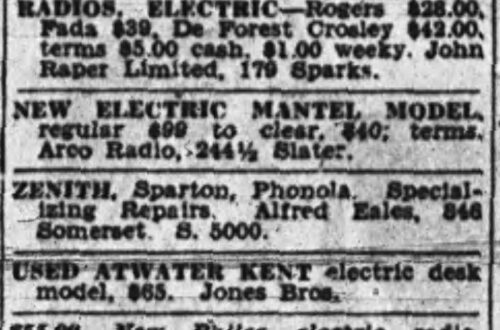
I’ve been researching the career of the Rev. Canon John Andrew Sloan (1855-1915), the Catholic priest who baptized, married, and buried many of my paternal ancestors, first at St. Patrick’s, Fallowfield/St. Isidore’s, South March, and then at St. Mary’s, Ottawa. Here is one of the interesting stories I have uncovered, of an “ingenious” swindle not only of Father Sloan (then parish priest at St. Bridget’s, Ottawa), but also of at least two dozen other reverend gentlemen, most of them Protestant clergymen, in Ottawa and Montreal.
Father Sloan Swindled

According to The Ottawa Citizen, in December 1907, a man by the name of Edward McEvoy “presented himself to Father Sloan with a tale of hard times.” McEvoy claimed to be a married man with four children, only recently arrived from Montreal, and he produced two documents in support of his request for assistance. The first was a “certificate of good character from a Catholic educational institutional in the metropolis [i.e., Montreal],” where McEvoy had reportedly worked as a janitor. And the second was “an equally strong” letter from a Montreal (and we can assume Catholic) clergyman. McEvoy also told the priest that he was about to take up a position under Mr. H.B. Spencer [Herbert Bush Spencer, 1856-1927] of the Canadian Pacific Railway. With no reason to doubt the authenticity of the glowing character references (the first of which was apparently written on the letterhead of a Montreal Catholic school), Father Sloan gave McEvoy $10 “from his charity fund.”1 This money was understood to be a loan, however, which McEvoy would repay as soon as he began collecting wages.

A few days after giving McEvoy the ten dollars, Father Sloan received a phone call from Mr. Spencer of the CPR, who
told him McEvoy had been put at work, and that, in the meantime, any money or goods given him by the priest would be repaid by Mr. Spencer himself. ‘Give him whatever he needs,’ was the way Mr. Spencer put it. McEvoy needed considerable funds, evidently.
the ottawa citizen, 27 Jan 1908
Over the course of the next few weeks, McEvoy obtained another $50 in cash and goods from Father Sloan, until the priest, finally growing impatient at Spencer’s failure to make good on “his promise to deduct the amount from McEvoy’s wages,” decided to telephone Mr. H.B. Spencer, Superintendent of the CPR. “To the good priest’s surprise,” he of course learned that Spencer had never even heard of Edward McEvoy, who certainly did not work for the Canadian Pacific Railway.2
In a later recap of this story, the Citizen offered an abbreviated version of its 27 January account, this time replacing Mr. H.B. Spencer of the CPR with another railway official of a different railway: apparently McEvoy had rung up Father Sloan claiming to be Mr. M. Donaldson [Morley Donaldson, 1851-1918] of the GTR (Grand Trunk Railway).
McEvoy in Ottawa Police Court

Edward McEvoy appeared in the Ottawa police court on the morning of 27 January 1908. Here Detective Thomas Ryan of the Ottawa police force asked for a remand of a week while he completed his inquiries. The remand was granted. Edward McEvoy next appeared in the Ottawa police court on 6 February 1908. Here he pleaded guilty to obtaining $10 from Father Sloan under false pretences. According to the Citizen, he was given the choice between three months in jail or a $32 fine. McEvoy chose the fine.

But in another variation of the story, on 7 February 1908 the Montreal Gazette reported that Edward McEvoy had been offered
the option of a fine of $30 and costs or three months in jail, or stop drinking, and his other evil ways, treat his wife properly and leave the city [i.e., the city of Ottawa]
the gazette (Montreal, que.), 7 february 1908
Here we have an Edward McEvoy with a drinking problem and a long-suffering wife, which certainly sounds plausible. But did the Ottawa police court magistrate really offer McEvoy a no-jail, no-fines option: just take your wife and leave the city, and there’s an end to it? That sounds awfully lenient for a con artist who had swindled a priest by impersonating a railway official.
And did Edward McEvoy have a wife and four children, as he reportedly told Father Sloan? I can find no evidence whatsoever of the four children, and I’m inclined to believe they were entirely fictitious, a literary device of the con man’s story. But I strongly suspect McEvoy did have a wife. More specifically, I suspect he was the Edward Henry McEvoy who had married an Annie Flowers at a Methodist church in Montreal in May 1907.3
McEvoy “Back into the Game”
Having narrowly escaped a jail sentence for his swindling of Father Sloan, apparently Edward McEvoy did lie low for the next little while. Did he (and his presumed wife?) return to Montreal after his brush with the Ottawa law in February 1908? Impossible to say. But by the summer of 1908, McEvoy was certainly back in Ottawa, and back into the game. And by late August, he was back in the Ottawa police court. On 26 August 1908, the Citizen reported that Henry4 McEvoy had
recently got back into the game and, the police state, has swindled nearly a dozen clergymen by first ringing them up and after telling them that Mr. Hugh Killeen, ‘assistant superintendent of J.R. Booth’s,’ was speaking, turning up as the deserving individual and securing money or goods
the ottawa citizen, 26 August 1908
In 1907 and 1908, Hugh William Killeen (1867-1940) did indeed work for J.R. Booth, as foreman of a work gang at Booth’s pulp mill. But how did McEvoy acquire his name, and the name of his employer? I’m assuming that McEvoy made use of the Ottawa City Directory to find the names and addresses of Ottawa-area clergymen and railway officials. But in both the 1906 and 1907 Ottawa city directories, Killeen was listed as “William Killeen, Lumberman,” at 111 Sherwood, a boarding house run by a Mrs. Susan Bradley.5 Perhaps McEvoy had heard of, or even met, Killeen through a common acquaintance? Or maybe he had briefly worked at Booth’s pulp mill before returning to a life of crime?

In any case, I can’t help but wonder how things might have gone had McEvoy used the name of Hugh Killeen for his first (or first-discovered) swindle. Father Sloan would have known Hugh Killeen personally: Hugh and his parents and siblings belonged to the parish of St. Mary’s, Ottawa, where Father Sloan had served as parish priest from 1899 to 1904. Moreover, Father Sloan would have also known many of Hugh Killeen’s numerous Killeen and Lahey aunts and uncles and cousins, who belonged to the parish of St. Isidore’s, South March. No matter how smooth and practiced his con man skills, there’s no way McEvoy could have pulled it off, had he telephoned Father Sloan claiming to be Hugh Killeen.

But McEvoy had used the name of a railway official in his swindling of Father Sloan, and here, surely, he was on safe ground. After all, what would a Catholic priest have to do with a railway official?
Well, as a matter of fact, Father Sloan did have some dealings with someone at the CPR. From 1884, he had organized an annual summer pilgrimage to the shrine at Ste. Anne de Beaupre. On 11 July 1884, the Ottawa Daily Citizen reported that Father Sloan “had completed all the arrangements for his pilgrimage,” later boasting that he and Father Whelan (St. Patrick’s, Ottawa) had made “the most advantageous arrangements possible with the Canadian Pacific Railway in regard to rates of fares and accommodations.”[The Ottawa Daily Citizen, 17 July 1884] Now, I’m not saying that he went all the way to the top, to the superintendent of the railway. But certainly Father Sloan was in contact with someone at the CPR, with whom he negotiated affordable prices for the hundreds of Ottawa-area Irish and French Catholics who attended his pilgrimage. McEvoy was always playing a dangerous game, in other words, which is why he kept getting caught.

As best I make out, it was his swindling of the Rev. W.A. Read [William Ashley Read, 1853-1931], rector of St. Luke’s Anglican Church in Ottawa, that finally got Edward McEvoy into real trouble. McEvoy had first telephoned the Rev. Read, claiming to be a Mr. Hugh Killeen “assistant superintendent at Booth’s,” and asking the minister to assist the worthy man who would shortly call at his house. After Rev. Read, quite wisely, indicated that he would require a letter from Killeen before he could assist the man, McEvoy himself soon “appeared with a touching epistle signed by Mr. Killeen, and secured $10 from the minister.”

As reported in The Ottawa Citizen, McEvoy now also faced a potential forgery charge, “should Mr. Killeen decide to go after McEvoy on this count.”6Killeen did pursue the charge, and on 31 August, McEvoy was found guilty of forgery, in addition to the charges of obtaining money under false pretences (“swindling”). He was sentenced to six months at hard labour “in the common jail.”7
Assuming he served all of his 6-month sentence, Edward McEvoy would have been released from the Carleton County Gaol around 1 March 1909. He had promised to leave Ottawa after serving his sentence, and he soon turned up in Montreal.
to be continued…
- The Ottawa Citizen, 27 January 1908. Father Sloan’s charity fund is an interesting story in its own right, and the subject of a future entry. ↩
- Ibid. ↩
- A few more details, however sketchy, in Part II. ↩
- McEvoy used a number of aliases, and was sometimes Edward, sometimes Henry McEvoy/McElroy/Giles/Stewart/Symonds. ↩
- Also at Mrs. Bradley’s boarding house were Hugh Killeen’s cousin (and godson) Denis Barnes, and a Robert Osser who was also a foreman at J.R. Booth’s pulp mill. ↩
- The Ottawa Citizen, 28 August 1908 ↩
- The Ottawa Citizen, 1 September 1908. The common jail was the Carleton County Gaol. ↩




